主位推进模式分析
- 格式:doc
- 大小:27.50 KB
- 文档页数:2
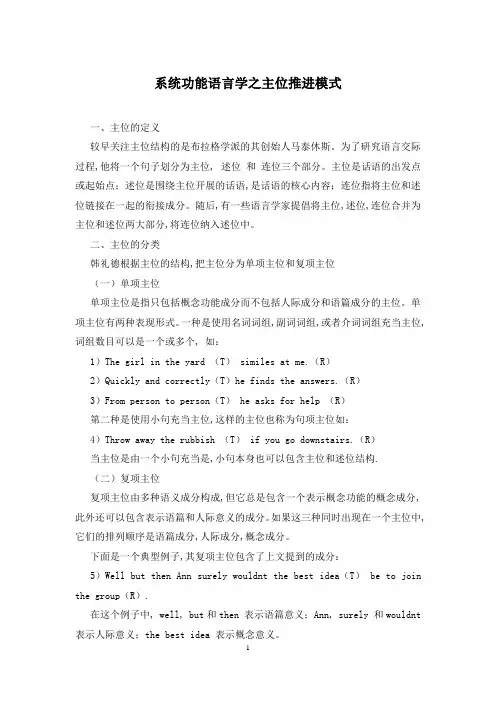
系统功能语言学之主位推进模式一、主位的定义较早关注主位结构的是布拉格学派的其创始人马泰休斯。
为了研究语言交际过程,他将一个句子划分为主位, 述位和连位三个部分。
主位是话语的出发点或起始点;述位是围绕主位开展的话语,是话语的核心内容;连位指将主位和述位链接在一起的衔接成分。
随后,有一些语言学家提倡将主位,述位,连位合并为主位和述位两大部分,将连位纳入述位中。
二、主位的分类韩礼德根据主位的结构,把主位分为单项主位和复项主位(一)单项主位单项主位是指只包括概念功能成分而不包括人际成分和语篇成分的主位。
单项主位有两种表现形式。
一种是使用名词词组,副词词组,或者介词词组充当主位,词组数目可以是一个或多个, 如:1)The girl in the yard (T) similes at me.(R)2)Quickly and correctly(T)he finds the answers.(R)3)From person to person(T) he asks for help (R)第二种是使用小句充当主位,这样的主位也称为句项主位如:4)Throw away the rubbish (T) if you go downstairs.(R)当主位是由一个小句充当是,小句本身也可以包含主位和述位结构.(二)复项主位复项主位由多种语义成分构成,但它总是包含一个表示概念功能的概念成分,此外还可以包含表示语篇和人际意义的成分。
如果这三种同时出现在一个主位中,它们的排列顺序是语篇成分,人际成分,概念成分。
下面是一个典型例子,其复项主位包含了上文提到的成分:5)Well but then Ann surely wouldnt the best idea(T) be to join the group(R).在这个例子中, well, but和then 表示语篇意义;Ann, surely 和wouldnt 表示人际意义;the best idea 表示概念意义。
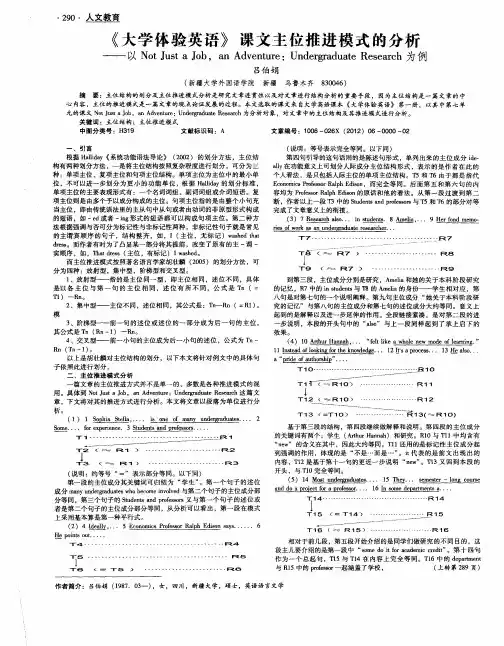

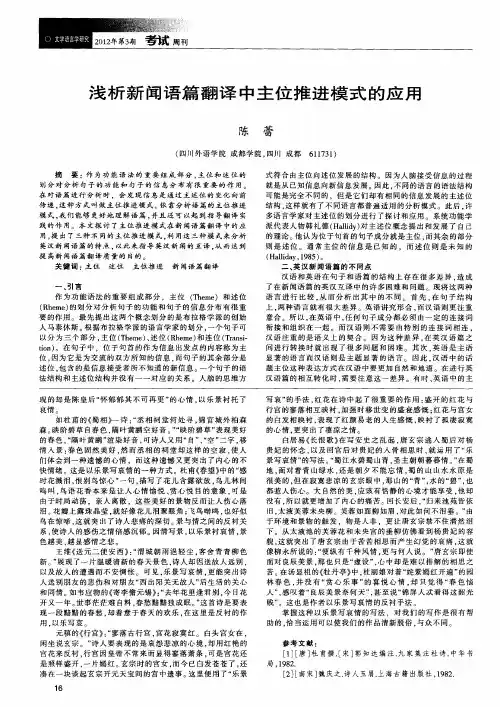
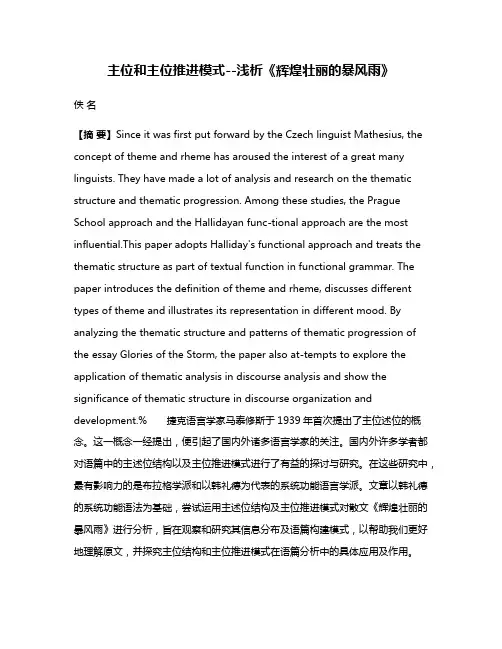
主位和主位推进模式--浅析《辉煌壮丽的暴风雨》佚名【摘要】Since it was first put forward by the Czech linguist Mathesius, the concept of theme and rheme has aroused the interest of a great many linguists. They have made a lot of analysis and research on the thematic structure and thematic progression. Among these studies, the Prague School approach and the Hallidayan func-tional approach are the most influential.This paper adopts Halliday's functional approach and treats the thematic structure as part of textual function in functional grammar. The paper introduces the definition of theme and rheme, discusses different types of theme and illustrates its representation in different mood. By analyzing the thematic structure and patterns of thematic progression of the essay Glories of the Storm, the paper also at-tempts to explore the application of thematic analysis in discourse analysis and show the significance of thematic structure in discourse organization and development.% 捷克语言学家马泰修斯于1939年首次提出了主位述位的概念。
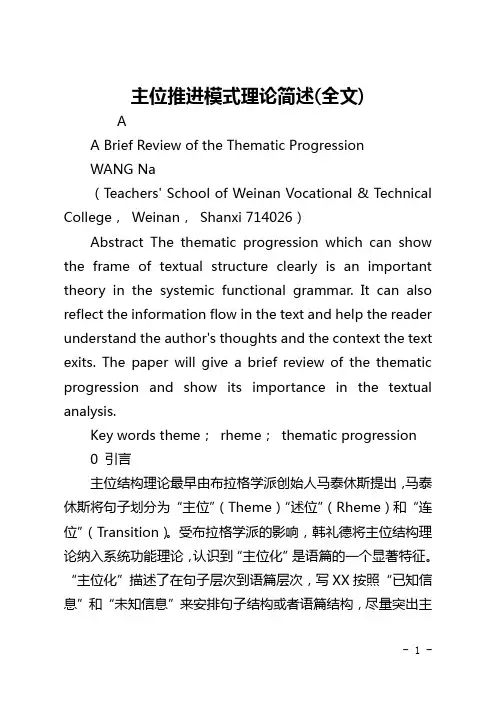
主位推进模式理论简述(全文)AA Brief Review of the Thematic ProgressionWANG Na(Teachers' School of Weinan Vocational & Technical College,Weinan,Shanxi 714026)Abstract The thematic progression which can show the frame of textual structure clearly is an important theory in the systemic functional grammar. It can also reflect the information flow in the text and help the reader understand the author's thoughts and the context the text exits. The paper will give a brief review of the thematic progression and show its importance in the textual analysis.Key words theme;rheme;thematic progression0 引言主位结构理论最早由布拉格学派创始人马泰休斯提出,马泰休斯将句子划分为“主位”(Theme)“述位”(Rheme)和“连位”(Transition)。
受布拉格学派的影响,韩礼德将主位结构理论纳入系统功能理论,认识到“主位化”是语篇的一个显著特征。
“主位化”描述了在句子层次到语篇层次,写XX按照“已知信息”和“未知信息”来安排句子结构或者语篇结构,尽量突出主题。
“已知信息”被放置在主位的位置上,而“未知信息”被放置在述位的位置上,从主位结构的安排上能够分析语篇的语义传递。
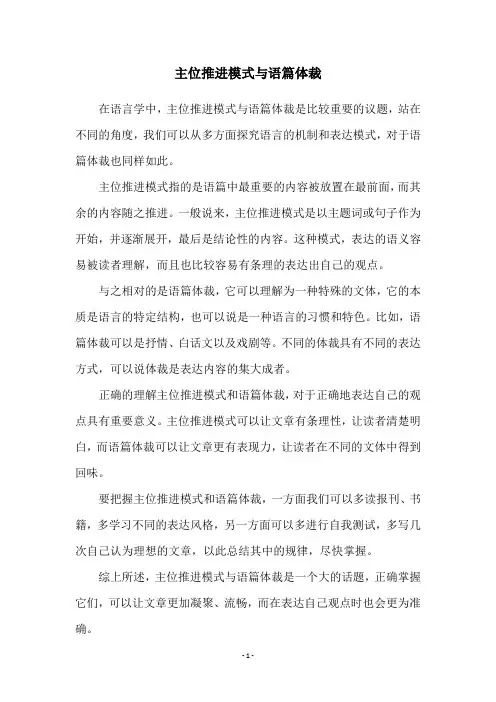
主位推进模式与语篇体裁
在语言学中,主位推进模式与语篇体裁是比较重要的议题,站在不同的角度,我们可以从多方面探究语言的机制和表达模式,对于语篇体裁也同样如此。
主位推进模式指的是语篇中最重要的内容被放置在最前面,而其余的内容随之推进。
一般说来,主位推进模式是以主题词或句子作为开始,并逐渐展开,最后是结论性的内容。
这种模式,表达的语义容易被读者理解,而且也比较容易有条理的表达出自己的观点。
与之相对的是语篇体裁,它可以理解为一种特殊的文体,它的本质是语言的特定结构,也可以说是一种语言的习惯和特色。
比如,语篇体裁可以是抒情、白话文以及戏剧等。
不同的体裁具有不同的表达方式,可以说体裁是表达内容的集大成者。
正确的理解主位推进模式和语篇体裁,对于正确地表达自己的观点具有重要意义。
主位推进模式可以让文章有条理性,让读者清楚明白,而语篇体裁可以让文章更有表现力,让读者在不同的文体中得到回味。
要把握主位推进模式和语篇体裁,一方面我们可以多读报刊、书籍,多学习不同的表达风格,另一方面可以多进行自我测试,多写几次自己认为理想的文章,以此总结其中的规律,尽快掌握。
综上所述,主位推进模式与语篇体裁是一个大的话题,正确掌握它们,可以让文章更加凝聚、流畅,而在表达自己观点时也会更为准确。
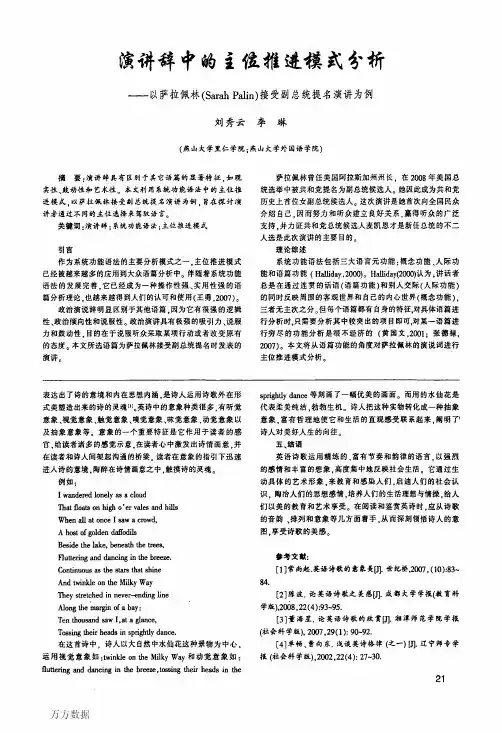
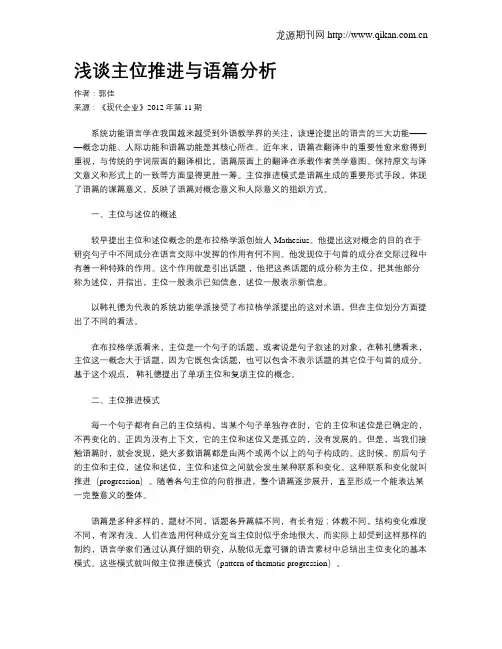
浅谈主位推进与语篇分析作者:郭佳来源:《现代企业》2012年第11期系统功能语言学在我国越来越受到外语教学界的关注,该理论提出的语言的三大功能———概念功能、人际功能和语篇功能是其核心所在。
近年来,语篇在翻译中的重要性愈来愈得到重视,与传统的字词层面的翻译相比,语篇层面上的翻译在承载作者美学意图、保持原文与译文意义和形式上的一致等方面显得更胜一筹。
主位推进模式是语篇生成的重要形式手段,体现了语篇的谋篇意义,反映了语篇对概念意义和人际意义的组织方式。
一、主位与述位的概述较早提出主位和述位概念的是布拉格学派创始人Mathesius。
他提出这对概念的目的在于研究句子中不同成分在语言交际中发挥的作用有何不同。
他发现位于句首的成分在交际过程中有着一种特殊的作用。
这个作用就是引出话题,他把这类话题的成分称为主位,把其他部分称为述位,并指出,主位一般表示已知信息,述位一般表示新信息。
以韩礼德为代表的系统功能学派接受了布拉格学派提出的这对术语,但在主位划分方面提出了不同的看法。
在布拉格学派看来,主位是一个句子的话题,或者说是句子叙述的对象,在韩礼德看来,主位这一概念大于话题,因为它既包含话题,也可以包含不表示话题的其它位于句首的成分。
基于这个观点,韩礼德提出了单项主位和复项主位的概念。
二、主位推进模式每一个句子都有自己的主位结构,当某个句子单独存在时,它的主位和述位是已确定的,不再变化的。
正因为没有上下文,它的主位和述位又是孤立的,没有发展的。
但是,当我们接触语篇时,就会发现,绝大多数语篇都是由两个或两个以上的句子构成的。
这时候,前后句子的主位和主位,述位和述位,主位和述位之间就会发生某种联系和变化。
这种联系和变化就叫推进(progression)。
随着各句主位的向前推进,整个语篇逐步展开,直至形成一个能表达某一完整意义的整体。
语篇是多种多样的,题材不同,话题各异篇幅不同,有长有短;体裁不同,结构变化难度不同,有深有浅。
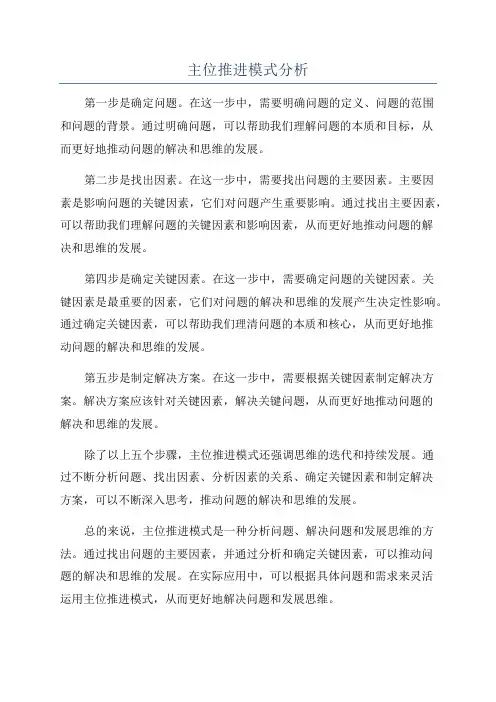
主位推进模式分析
第一步是确定问题。
在这一步中,需要明确问题的定义、问题的范围
和问题的背景。
通过明确问题,可以帮助我们理解问题的本质和目标,从
而更好地推动问题的解决和思维的发展。
第二步是找出因素。
在这一步中,需要找出问题的主要因素。
主要因
素是影响问题的关键因素,它们对问题产生重要影响。
通过找出主要因素,可以帮助我们理解问题的关键因素和影响因素,从而更好地推动问题的解
决和思维的发展。
第四步是确定关键因素。
在这一步中,需要确定问题的关键因素。
关
键因素是最重要的因素,它们对问题的解决和思维的发展产生决定性影响。
通过确定关键因素,可以帮助我们理清问题的本质和核心,从而更好地推
动问题的解决和思维的发展。
第五步是制定解决方案。
在这一步中,需要根据关键因素制定解决方案。
解决方案应该针对关键因素,解决关键问题,从而更好地推动问题的
解决和思维的发展。
除了以上五个步骤,主位推进模式还强调思维的迭代和持续发展。
通
过不断分析问题、找出因素、分析因素的关系、确定关键因素和制定解决
方案,可以不断深入思考,推动问题的解决和思维的发展。
总的来说,主位推进模式是一种分析问题、解决问题和发展思维的方法。
通过找出问题的主要因素,并通过分析和确定关键因素,可以推动问
题的解决和思维的发展。
在实际应用中,可以根据具体问题和需求来灵活
运用主位推进模式,从而更好地解决问题和发展思维。
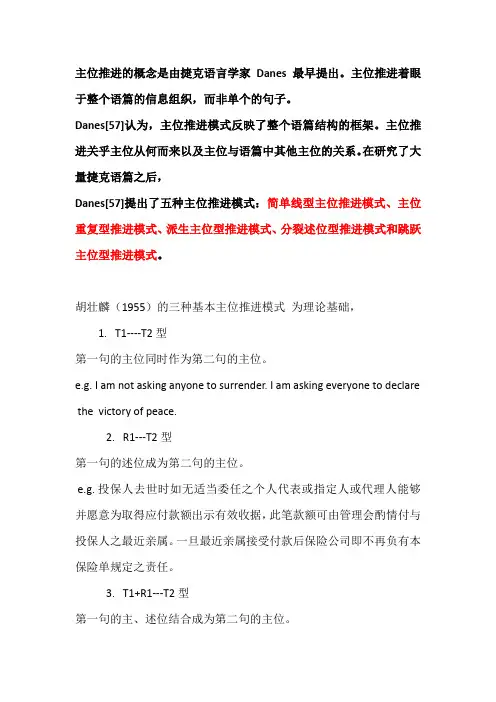
主位推进的概念是由捷克语言学家Danes 最早提出。
主位推进着眼于整个语篇的信息组织,而非单个的句子。
Danes[57]认为,主位推进模式反映了整个语篇结构的框架。
主位推进关乎主位从何而来以及主位与语篇中其他主位的关系。
在研究了大量捷克语篇之后,Danes[57]提出了五种主位推进模式:简单线型主位推进模式、主位重复型推进模式、派生主位型推进模式、分裂述位型推进模式和跳跃主位型推进模式。
胡壮麟(1955)的三种基本主位推进模式为理论基础,1.T1----T2型第一句的主位同时作为第二句的主位。
e.g. I am not asking anyone to surrender. I am asking everyone to declare the victory of peace.2. R1---T2型第一句的述位成为第二句的主位。
e.g. 投保人去世时如无适当委任之个人代表或指定人或代理人能够并愿意为取得应付款额出示有效收据,此笔款额可由管理会酌情付与投保人之最近亲属。
一旦最近亲属接受付款后保险公司即不再负有本保险单规定之责任。
3. T1+R1---T2型第一句的主、述位结合成为第二句的主位。
e.g. He failed the entrance examination. This made his parents upset.主述位理论是语篇语言学的一个重要部分。
主位(Theme)和述位(Rheme)这一概念是1939年由布拉格学派创始人之一捷克语言学家马泰修斯Mathesuis提出来的。
他提出这对概念的目的在于研究句中的不同成分在语际交换中发挥的作用有何不同。
主位就是在旬中充当论述的起点,是位于句首的成分,在交际中有一种特殊的作用,把除了主位以外的其他成分叫做述位。
系统功能语言学派的代表人物Halliday接受了这一理论,并在此基础上对其功能和分类提出了一些新的观点。
Mbappe’s year to remember() 20 Dec 2017Over the last 12 months, Kylian Mbappe has gone from being a promising young talent to a bona fide star of the game. Building on his meteoric rise with Monaco, he has now established himself in the France side and with his new club Paris Saint-Germain, racking up a number of age-related records in the process. Despite being showered with praise, he shows no signs of straying from his goal of becoming a footballing legend and going down in the history of the game.。
收稿日期:2008-02-02作者简介:梁汉平(1966-),男,湖北嘉鱼人,广西贺州学院外语系副教授,硕士,主要研究方向为语言学,教学论。
一、引言在系统功能语法中,主述位结构、信息结构和衔接系统同属语篇功能的子系统,它们都可促成语篇的连贯。
写作就是用书面语言表达自己的思想的过程,也是用书面语言影响别人的过程。
Halliday[1]指出:“判断一系列句子是否构成了一个篇章取决于句内与句间的连贯关系,是连贯关系决定了一系列句子的篇章性”。
一段篇章不只是一些语法和词汇的简单载体,更是作者思想,文化背景,语言风格的综合体现,而衔接成分恰好是把作者的思想串联成篇的纽带。
把主述位理论及主位推进模式正确灵活地应用到英语教学,尤其是写作教学中恰好有助于增强学生的英语写作能力,能更好地实现语篇衔接和语篇连贯。
二、主位述位最早提出主位(theme)和述位(rheme)概念的是布拉格学派创始人之一Mathesius,他提出这对概念的目的在于研究句子中不同成分在语言交际过程中发挥的作用有何不同。
他发现,位于句首的成分在交际过程中有着一种特殊的作用。
这个作用就是充当论述的起点。
他把这类起点成分称为主位,把其它部分称为述位,并指出,主位一般表示已知信息,述位一般表示新信息。
以Halliday为代表的系统功能学派接受了布拉格学派提出的这对概念,但在主位划分方面提出了不同看法。
Halliday更注重句子和语篇中各个成分所发挥的语义功能。
他认为,在句子层面上,有两个位置最值得注意。
一个是句末,一个是句首。
句末位置一般是句子的信息中心(informationfocus)所在,即句子所要表达的最重要的新信息。
而句首位置一般是句子的起始部分,全句的内容是从这里开始的。
Halliday是从功能而不是从成分分布的角度对主位进行界定的,并认为,主位是“信息(message)的起点(pointofdeparture),是小句所关心的成分(theelementwithwhichtheclauseisconcerned)”。
The Constrastive Analysis of the Thematic Structure in Scientific English and Chinese 英语科技语体主位推进模式对比分析赵红,王新梅(重庆外国语学院,重庆400044)本文以捷克语言学家丹尼斯(F•Danes)提出的“主位推进模式”(Thematic progression)为理论基础,对英汉科技语篇进行实例分析,归纳出科技语体的主位推进模式及英汉科技语体主位推进模式的特点和异同。
一、观点分歧:1. 马泰休斯(V-Mathesius,1939),韩礼德(Halliday,1985)的功能主义观,一个句子可以从交际功能的角度划分主位和述位。
主位是句子的第一个成分,是叙述的出发点。
述位是句子的其他部分,是对主位的叙述,描写和说明。
2. 丹尼斯(F•Danes)认为,篇章的真正主位结构是指主位的衔接和连接,每个语篇可以看成一个主位的序列。
(Danes, 1969)二、“主位推进模式”理论综述A.代表人物: 捷克语言学家丹尼斯(F•Danes)“主位推进模式”五种常见主位推进模式类型1.简单线性主位化推进模式(The rheme in the first clause is the theme of the nextclause)第一句的述位成为第二句的主位。
e.g.绒花。
2. 连贯主位模式(The rheme in the first clause turns to be the theme of eachfollowing clause)第一句的述位成为以后各句的主位。
e.g.暗。
3. 派生主位推进模式(the superrheme goes throughout the following chause)同一主位贯穿于紧随其后的语义紧密相联的句子中。
e.g.4. 分裂述位模式(The superrheme overcontrols the themes following the firstclause)第一句的述位的各部分内容分别做后面句子的主位。
《葛底斯堡演说词》的主位分析主位理论是韩礼德系统功能语法中语篇纯理功能的重要组成部分。
本文以主位理论为基础,以林肯在美国内战时期发表的著名演说《葛底斯堡演说词》为语料,通过分析《葛底斯堡演说词》的主位、述位以及主位的推进模式,有助于更好地研究语篇的信息分布,从而更好地了解作者的本质意图。
标签:主位理论;主位推进;信息流动;语篇分析一、引言布拉格学派的代表人物马泰修斯认为,一个句子可以划分为“主位”(Theme)、“述位”(Rheme)和“连位”(Transition)三个部分。
主位是话语的出发点;述位则是围绕主位所说的话,往往是话语的核心内容;连位是把主位和述位连接起来的过渡成分。
后来,很多语言学家继续研究探讨,提出了不少新见解。
他们多数人主张把主位、连位和述位三个部分合并成主位和述位两大部分,把连位看作是述位的一个组成部分。
系统功能学派代表人物韩礼德(1994/2000:38)和汤姆森(2000:19)接受并发展了这一理论,指出任何句子或话语从交际功能角度出发均可分为主位和述位。
主位是小句第一成分, 是信息的起点,小句剩余部分(remainder)统称为述位。
语言学家研究发现:人们说话时,总是按照某些词语在交际中所体现的功能来确定哪些话先说,哪些话后说。
先说的是主位,它是说话的出发点,是说话人要强调的部分; 主位之后围绕主位展开的部分是述位。
二、主位的分类主位有标记性(marked)和无标记性(unmarked)之分。
充当主位的成分可以是句子的主语、谓语、宾语、表语和状语等句子成分。
当小句的主位同时也是小句的主语时,被称为无标记性主位;如果主位不是小句的主语,那么主位被称为标记性主位。
例如:(1) The man (T) // was heling police enquiries last night. (R)(2) Last night (T) // the man was helping police enquiries. (R)上面两个例子,句子意思基本相同,但由于信息的起点不同,所强调的成分也有所不同。
从主位推进模式分析培根《论读书》的三个汉语译本功能语言学中的主述位推进模式是语篇生成的重要形式。
近年来,语篇在翻译中的重要性越来越受到译者的推崇,因此主述位推进模式是指导译者的重要原则。
本文把主述位推进模式作为重要的参考依据,对培根的名篇《论读书》的三个汉语译本进行对比分析。
可以发现,在译者组织译语语篇时,把握主位述位之间的联系变化,既有利于忠实地翻译出原文,也有利于全面地再现原文的语篇风格。
标签:主位同一模式主位派生模式述位同一模式述位派生模式近年来,语篇在翻译中有着举足轻重的地位。
与传统的字词层面的翻译相比,语篇层面上的翻译在承载作者美学意图、保持原文与译文意义和形式上的一致等方面显得更胜一筹。
主述位推进模式是语篇生成的重要形式,体现了语篇的谋篇意义,反映了语篇对概念意义和人际意义的组织方式。
译者在翻译时应该分析原文的主述位推进模式,这样不仅能够把握原文的信息传输方向,而且能够再现原文的风格,使译文与原文形神皆似。
一、主位推进模式捷克语言学家丹尼斯是第一个提出“主位推进模式”这一概念的人。
他在《论语言分析与语篇结构》一文中指出:每个语篇及其段落都可以被看成是主位的序列。
篇章的主位结构是指主位间的连贯、衔接、相互指代关系和领属关系,以及主位同段落、整个语篇和情景的关系。
丹尼斯把篇章中所有这些复杂的主位关系称作“主位推进模式”,并明确指出,这种主位推进模式体现出篇章结构的框架。
他将主位推进模式分为5种:简单线性模式、连贯主位模式、派生模式、分裂述位模式和跳跃主位模式。
我国学者也对主述位推进模式作过研究。
朱永生(1995)认为主位结构最基本的发展模式有4种:主位延续型、述位延续性、直线延续型和交叉延续型;徐盛桓(1982)提出句子组合的4种发展模式:平行型(主位同一型)、集中型(述位同一型)、延续型(梯形)和交叉型;黄衍(1985:34~35)认为英语的主位推进模式有7种:平行型、延续型、集中型、交叉型、并列型、派生型、跳跃型。
主位推进模式研究综述主位推进模式(Subject-Prominent Language)是语言学中一个重要的研究领域,它指的是语言中主语在句子结构中起到更为突出和重要的作用。
随着语言学研究的不断深入,主位推进模式在不同语言中的表现方式和影响机制也得到了广泛关注。
本文将对主位推进模式的相关研究进行综述,探讨其在语言学领域的意义和影响。
首先,我们需要了解主位推进模式在不同语言中的表现方式。
在英语等一些以"主谓宾"结构为主的语言中,主语往往比其他成分更加突出,起到句子的主导作用。
而在一些以"动宾主"结构为主的语言中,主语的重要性则相对较弱。
此外,在一些高度灵活的语言中,比如汉语,主位推进模式的表现方式也可能更为复杂多样,受到语境和语用等多方面因素的影响。
其次,主位推进模式对语言交流和理解的影响也是一个备受关注的话题。
一般来说,使用主位推进模式的语言更加直接清晰,逻辑性更强,有助于信息的准确传递和理解。
相反,如果语言中主位推进模式的表现较弱,可能会导致信息传递的不清晰和歧义,增加交流的困难度。
因此,研究主位推进模式对语言交流和理解的影响,对于提高语言教学和翻译工作的效率和质量具有积极的意义。
另外,主位推进模式的研究也有助于我们更深入地理解语言的结构和演化。
语言作为人类思维和文化的工具,其结构和表达方式往往反映了一定的认知方式和社会背景。
通过比较不同语言中主位推进模式的差异和相似,我们可以更好地探讨语言的普遍规律和独特特点,深入理解语言的演化过程和影响因素。
让我们总结一下本文的重点,我们可以发现,主位推进模式作为语言学研究中的重要议题,其研究内容涉及语言结构、交流理解和语言演化等多个方面,对于推动语言学理论的发展和实践的应用具有重要意义。
希望通过本文的综述,读者能够更全面地了解主位推进模式的相关研究现状和意义,为今后的研究工作和实践探索提供一定的启示和借鉴。
Exercise: Analyze the thematic progressive pattern of the following text and try to illustrate how such a pattern contributes to the coherence of the text.
Teachers should take steps to prevent students from cheating on exams. (2) To begin with, teachers should stop reusing old tests. (3) Even a test that has been used once is soon known on the student grapevine(小道消息). (4) Students will check with their friends to find out, for example, what was on Dr. Thompson’s biology final last term. (5) They may even manage to turn up a copy of the test itself, “accidentally” not turned in by a former student of Dr. Thompson’s. (6) Teachers should also take some common sense precautions(防范措施)at test time. (7) They should make students separate themselves -- by at least one seat -- during an exam, and they should watch the class closely. (8) The best place for the teacher to sit is in the rear of the room, so that a student is never sure if the teacher is looking at him or her. (9) Last of all, teachers must make it clear to students that there will be severe penalties for cheating. (10) Anyone caught cheating should immediately receive a zero for the exam.
(1) Teachers (T1) should take steps to prevent students from cheating on exams (R1). (2) To begin with, teachers (T2) should stop reusing old tests (R2). (3) Even a test (T3) that has been used once is soon known on the student grapevine (R3). (4) Students (T4) will check with their friends to find out, for example, what was on Dr. Thompson’s biology final last term (R4). (5) They (T5) may even manage to turn up a copy of the test itself, “accidentally” not turned in by a for mer student of Dr. Thompson’s (R5). (6) Teachers (T6) should also take some common sense precaution at test time (R6). (7) They (T7) should make students separate themselves -- by at least one seat -- during an exam, and they should watch the class closely (R7). (8) The best place (T8) for the teacher to sit is in the rear of the room, so that a student is never sure if the teacher is looking at him or her (R8). (9) Last of all, teachers (T9) must make it clear to students that there will be severe penalties for cheating (R9). (10) Anyone (T10) caught cheating should immediately receive a zero for the exam (R10).
Here is the thematic progressive pattern of this text.
T1 — R1
T2 (=T1) — R2
T3 (=R2) — R3
T4 — R4
T5 (=T4) — R5
T6 — R6
T7 (=T6) — R7 T8 — R8
T9 — R9
T10 — R10。